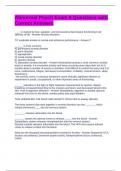Abnormal Psych Exam II Questions with
Correct Answers
____ is marked by fear, agitation, and nervousness that impairs functioning in all
spheres of life - Answer-Anxiety disorders
T/f: moderate anxiety is normal and enhances performance - Answer-T
______ is most common
A) generalized anxiety disorder
B) panic disorder
C) agoraphobia
D) social anxiety disorder
E) specific phobias
F) Separation anxiety disorder - Answer-Generalized anxiety is most common: anxiety
leads to anxiety. It is excessive anxiety and worry occurring more days than not for 6
months about a number of events or activities. Find difficult to control the worry and 3 or
more: restlessness, fatigue, decreased concentration, irritability, muscle tension, sleep
disturbance
- the anxiety, worry, or physical symptoms cause clinically significant distress or
impairment in social, occupational, or other important areas of functioning.
______ activation is the fight or flight response characterized by quicker, deeper
breathing, increased blood flow to the muscles and brain, and decreased blood to the
skin. How is digestion affected? - Answer-Sympathetic; digestion is slowed, glucose
released from liver to the blood, sweaty palms and pupil dialation.
THIS UNDERLIES THE FEAR AND ANXIETY INVOLVED in anxiety disorder
The three systems that work together in anxiety disorders are the _______, which
release (hormone)____ into the nervous system.
___ ____ releases adrenaline into the blood.
_______ causes the adrenal cortex to release _____ into the blood - Answer-
Sympathetic system releases norepinephrine into the nervous system.
Adrenal medulla releases adrenaline into the blood. The HPA axis causes adrenal
cortex to release cortisol into the blood.
What are the disrupted neurotransmitters involved in Anxiety - Answer-Dopamine (VTA,
Nucleus accumbens); Serotonin (raphe nuclei); Norepinephrine (locus coreleous);
GABA
,T/f: anxiety is also associated with increased parasympathetic activity and muscle
tension - Answer-T; even though associated with the sympathetic system and
norepinephrine released, also associated with increased parasympathetic activity and
muscle tension
The psychological factors of anxiety:
1) _____ is the search for threats.
2) ______
3) _________ Explain negative reinforcement - Answer-It is characterized by
hypervigilance or the search for threats, out of control worrying, and the worry staves off
panic. This is an example of negative reinforcement because it is the removal of an
aversive stimulus (panic) through worrying. This is an example of *Nonproductive
thinking* because it is not problem solving.
Social factors for GAD include death, friction in friendships, and troubled employment.
People with GAD see themselves as having _______ when they may not. - Answer-
Troubled relationships
What are the treatments for GAD:
Some include Buspirone, which decreases the serotonin release and may affect
amygdala activity. - Answer-SNRIs, SSRIs (work on both anxiety and depression) and
BENZOdiazpines.
There is behavioral therapy including breathing retraining, muscle relaxation and
BIOFEEDBACK, and habituation with exposure therapy. This includes imagined, virtual,
and in Vivo.
On the cognitive branch, there is psychoeducation
Meditation to let go
Self monitoring with a daily log
Problem solving in specific terms
And cognitive restructuring
It is important to note that should not give too much medication because need to know
the feeling of anxiety when exposed to it in order to habituate to it. This is exposure
therapy.
Explain the process of worry exposure therapy, used to treat generalized anxiety
disorder - Answer-Exposure to the worry, think about it at length. Goal is to habituate to
the worry. Then generate possible rational alternative to the worst case scenario. Then
move onto another specific worry
A ______ is an intense fear, dread, doom and physical symptoms, like pounding heart.
Sudden onset, short duration. - Answer-Panic attack
, _____ ____ is characterized by freq panic attacks and fear about having another panic
attack and losing control. Think of "narrowing of one's life" due to fear - Answer-Panic
disorder (a significant maladaptive change in behavior related to the attacks, like
avoidance behaviors of exercise or similar situations that can lead to symptoms similar
to those experienced during an attack)
How can panic attacks be "cued"? - Answer-Running, change respiration rate, think
having a panic attack when normal physiological response. This "cuing" can lead to a
significant maladaptive change in behavior related to the attacks, like avoiding certain
situations that can trigger these feelings.
___ of the people with Agoraphobia have panic disorder. There are 2x more women
than men with this disorder - Answer-Half
_____ is a marked fear or anxiety about two or more of the following situations
- using public transportation
- being in open spaces
- enclosed spaces
- standing in line or being in a crowd
- being outside of the home alone
The individual fears or avoids these situations because of thoughts that escape might
be difficult or help might not be available in the event of developing panic like symptoms
or incapacitating or embarrassing symptoms
Fear or anxiety is out of proportion to the actual danger posed by the situation
Want to be with a companion - Answer-Agoraphobia
Neurological factors for panic disorder and. Agoraphobia:
Low threshold for detecting ______.
(Can be stimulated by an increase in Co2, also caused by caffeine and sodium lactate)
Dysregulation of the NT ______.
A ________ ___. - Answer-Low threshold detecting suffocation (can be stimulated by
hyperventilation which increases CO2 levels and stimulates suffocation); norepinephrine
dysregulation; genetic predisposition. Concordance rate: Genes in common, increase in
concordance
Psychological factors to panic disorder and agoraphobia:
___ ____ is a conditioned response to true alarm. It leads to false alarms--> panic
attacks. Responding to interoceptive and external cues of initial episode. This is a fear
of fear.
Cognitive influences include:
______. _______, or assuming that physiological changes like heart rate or respiratory
rate signal eminent danger, like a heart attack.




